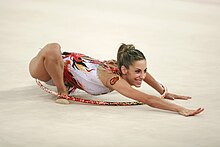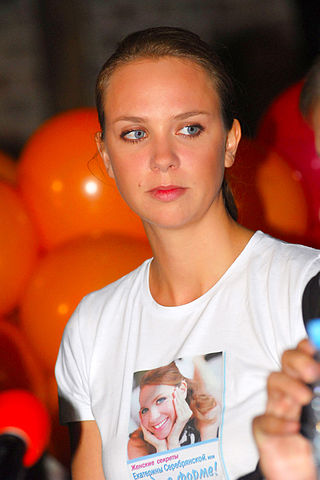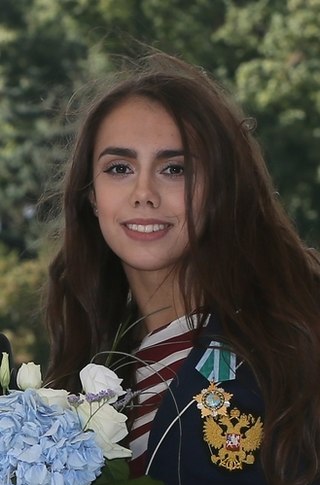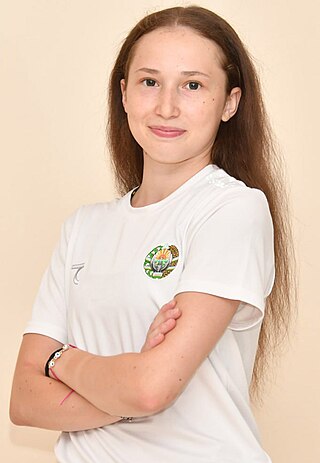
The hoop is an apparatus used in the sport of rhythmic gymnastics. It is one of the five apparatuses utilized in this discipline, alongside the ball, clubs, ribbon, and rope.

The hoop is an apparatus used in the sport of rhythmic gymnastics. It is one of the five apparatuses utilized in this discipline, alongside the ball, clubs, ribbon, and rope.
The hoop was introduced to the early form of the sport in the 1920s. [1] At the 1936 Summer Olympics, Hinrich Medau, one of the developers of "modern gymnastics" (the forerunner to rhythmic gymnastics), choreographed a routine with five hoops to represent the Olympic rings, popularizing the apparatus in gymnastics programs. [2] Hoops were used in the team portable apparatus competitions for women at both the 1952 and 1956 Olympics before the event was discontinued. [1] During the 1960s, the International Gymnastics Federation established official rules and competitions for rhythmic gymnastics. The hoop was recognised as an official apparatus from the beginning, along with the ball and rope. [3] From 2001-2012, each apparatus had a compulsory body group of movements that had to predominate in the exercise; hoop was an exception in requiring a balance of all four body groups. [4]
Over the years, the design and materials of the hoop have evolved to enhance performance. Early hoops were often made of wood, but modern hoops are typically constructed from durable plastics that can withstand rigorous use and provide better flexibility.

The hoop may be made of plastic or wood. It is common to bind the hoop with decorative tape to add strength, weight, and color. [3] The official specifications for the hoop are as follows: [5]
Rhythmic hoops are springy and can be easily rebounded, and the size and shape makes its trajectory stable when flown. [6] However, the large size and relative fragility of the hoop can cause difficulties when gymnasts fly to competitions. [7]
Many of the techniques of rhythmic gymnastics have been adopted by the modern hooping community.
Gymnasts perform a variety of elements with the hoop, including high or low throws, spinning it around different body parts like a hula hoop, or suspending it from the body with no support during a rotational body difficulty. During the exercise, the gymnast should perform elements with the hoop moving on different planes and axes and in different directions. The elements that are considered to be particular to the hoop are: [8]

Gymnastics is a type of sport that includes physical exercises requiring balance, strength, flexibility, agility, coordination, artistry and endurance. The movements involved in gymnastics contribute to the development of the arms, legs, shoulders, back, chest, and abdominal muscle groups. Gymnastics evolved from exercises used by the ancient Greeks that included skills for mounting and dismounting a horse, and from circus performance skills.

Rhythmic gymnastics is a sport in which gymnasts perform on a floor with an apparatus: hoop, ball, clubs, ribbon and rope. The sport combines elements of gymnastics, dance and calisthenics; gymnasts must be strong, flexible, agile, dexterous and coordinated. Rhythmic gymnastics is governed by the International Gymnastics Federation (FiG), which first recognized it as a sport in 1963. It became an Olympic sport in 1984, with an individual all-around event. The group all-around competition was added to the Olympics in 1996. At the international level, rhythmic gymnastics is a women-only sport. The most prestigious competitions, besides the Olympic Games, are the World Championships, World Games, European Championships, European Games, the World Cup Series and the Grand Prix Series. Gymnasts are judged on their artistry, execution of skills, and difficulty of skills, for which they gain points. They perform leaps, balances, and rotations along with handling the apparatus.

Natalia Oleksandrivna Godunko is a Ukrainian former rhythmic gymnast. She is the 2001 team all-around world champion, 2005 European ribbon champion and the 2004 Grand Prix Final all-around champion.

Kateryna Serebrianska[a] is a Ukrainian former individual rhythmic gymnast. She is the 1996 Olympics gold medalist, the 1995 World All-around champion, a two time (1995,1996) European All-around champion, and three time Grand Prix Final All-around champion.

The ball is an apparatus used in the sport of rhythmic gymnastics. It is one of the five apparatuses utilized in this discipline, alongside the clubs, hoop, ribbon, and rope.

The clubs are an apparatus used in the sport of rhythmic gymnastics. They are one of the five apparatuses utilized in this discipline, alongside the ball, hoop, ribbon, and rope.

The ribbon is an apparatus used in the sport of rhythmic gymnastics. It is one of the five apparatuses utilized in this discipline, alongside the ball, clubs, hoop, and rope.
Anelia Ralenkova became one of Bulgaria's most distinctive rhythmic gymnasts. She is one of the "Golden Girls" of Bulgaria that dominated rhythmic gymnastics in the 1980s.
This is a general glossary of the terms used in the sport of gymnastics.

Evgeniya Olegovna Kanaeva OMF is a retired Russian individual rhythmic gymnast. She is the only individual rhythmic gymnast in history to win two Olympic all-around gold medals, winning at the 2008 Summer Olympics, where she finished with 3.75 points ahead of silver medalist Inna Zhukova, and at the 2012 Summer Olympics, where she also became the oldest gymnast to win the Olympic gold. On 4 July 2013, Kanaeva received the International Fair Play Award for "Sport and Life".

Melitina Dmitryevna Staniouta is a Belarusian retired individual rhythmic gymnast. She is a three-time World all-around bronze medalist, the 2015 European Games all-around bronze medalist, the 2014 European Championships all-around silver medalist, and 2009 Grand Prix Final all-around bronze medalist.

Margarita Mamun is a retired Russian individual rhythmic gymnast of Bangladeshi-Russian descent. She is the 2016 Olympic All-around champion, two-time World All-around silver medalist, the 2015 European Games All-around silver medalist, the 2016 European Championships All-around silver medalist, three-time Grand Prix Final All-around champion and a three-time (2011–2013) Russian National All-around champion.

Yana Alexeyevna Kudryavtseva is a retired Russian individual rhythmic gymnast. She is the 2016 Olympic All-around silver medalist, three-time World Champion in the All-around (2013–2015), the 2015 European Games All-around champion, two-time European Championships All-around champion, the 2012 European Junior ball champion. In national level, she is a two-time Russian National All-around champion and three time Russian Junior National all-around champion.

Linoy Ashram is a retired Israeli individual rhythmic gymnast. She is the 2020 Olympic All-around Champion, the 2018 World All-around silver medalist, two-time World All-around bronze medalist, the 2020 European All-around champion, and the 2019 European Games All-around silver medalist. She is the third Israeli athlete and first Israeli woman to win an Olympic gold medal in any sport, and the first Israeli rhythmic gymnast to win an Olympic medal.
Alexandra Ana Maria Agiurgiuculese is a Romanian-Italian individual rhythmic gymnast who represents Italy. She is a World Championships silver and bronze medalist, and she competed at the 2020 Summer Olympics. Agiurgiuculese was the first Italian gymnast to win the Longines Prize for Elegance. At the national level, she is the 2019 Italian National all-around champion and three-time Italian National all-around silver medalist.

Ekaterina Olegovna Vedeneeva is a Slovenian individual rhythmic gymnast.

Sofia Raffaeli is an Italian individual rhythmic gymnast. She is the 2022 World all-around, hoop, ball, ribbon and team champion, the 2023 World all-around, hoop and ball silver medalist, the 2023 European ball and clubs champion and silver all-around medalist, the 2024 European ball champion and all-around and ribbon silver medalist and the 2022 European hoop and clubs champion. She is also the 2019 Junior World silver medalist with rope and clubs. She is the first Italian individual rhythmic gymnast to win a gold medal at the World Championships, European Championships and World Games, and she has won seven all-around gold medals in the FIG World Cup circuit.

Stiliana Nikolova is a Bulgarian individual rhythmic gymnast. She is the 2024 European all-around champion, the 2022 World all-around bronze medalist and hoop, clubs, and ribbon silver medalist, the 2023 World ball bronze medalist and team competition champion, and a two-time European all-around bronze medalist and champion in the team competition. At the national level, she is a two-time national champion and the 2022 national all-around silver medalist.

Daria Atamanov is an Israeli individual rhythmic gymnast. She is the 2022 European all-around Champion and the 2023 World Championship all-around bronze medalist. She is also the 2022 European Championship silver medalist in hoop, clubs, ribbon, and the team bronze medalist. On a national level, she is the 2022 & 2024 Israeli National all-around champion and a two-time Israeli Junior National all-around champion. Atamanov will represent Israel at the 2024 Summer Olympics in Paris in the Women's rhythmic individual all-around on August 8-10, 2024.

Takhmina Ikromova is an Uzbekistani rhythmic gymnast. She is an Asian Games champion individually and in the team event, and she is also a two-time all-around champion at the Asian Rhythmic Gymnastics Championships, in 2022 and 2023.